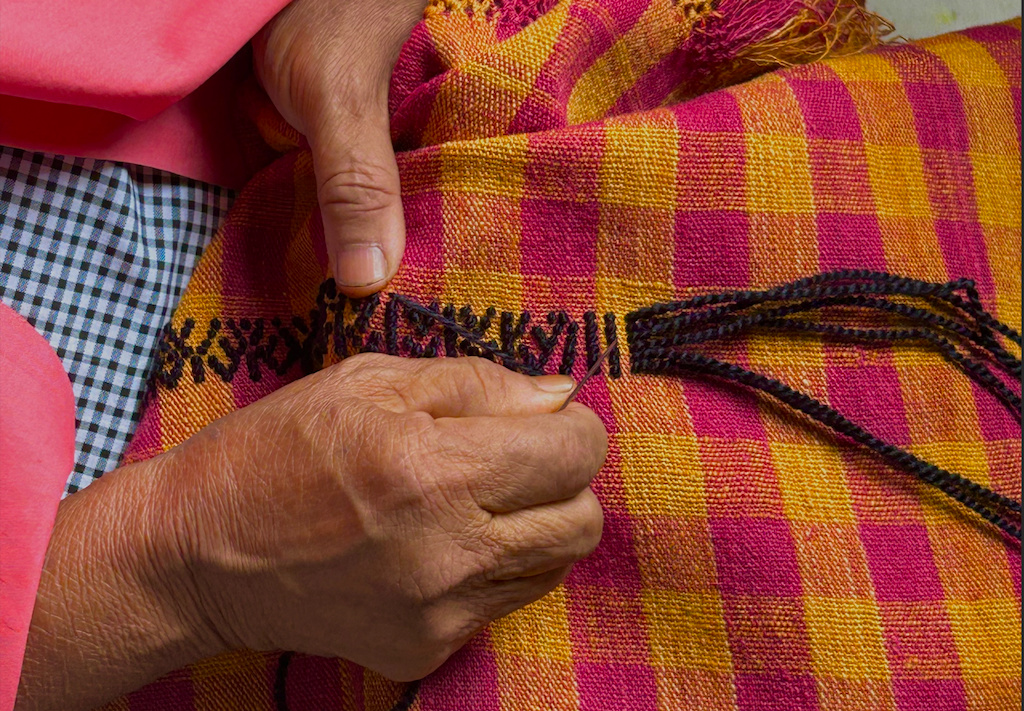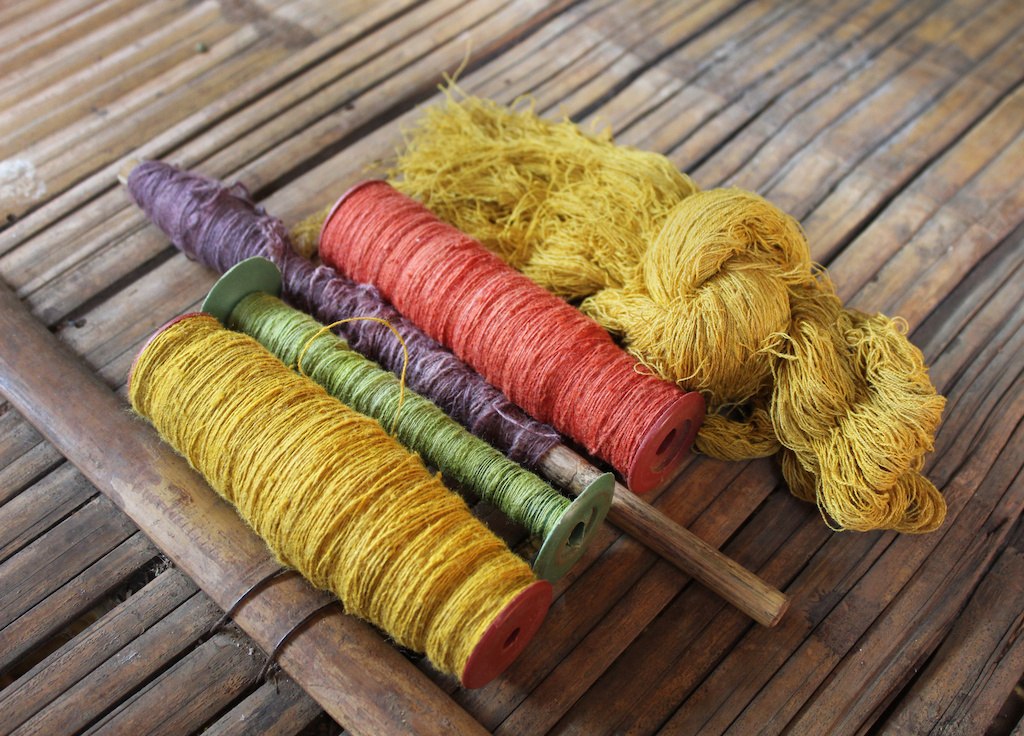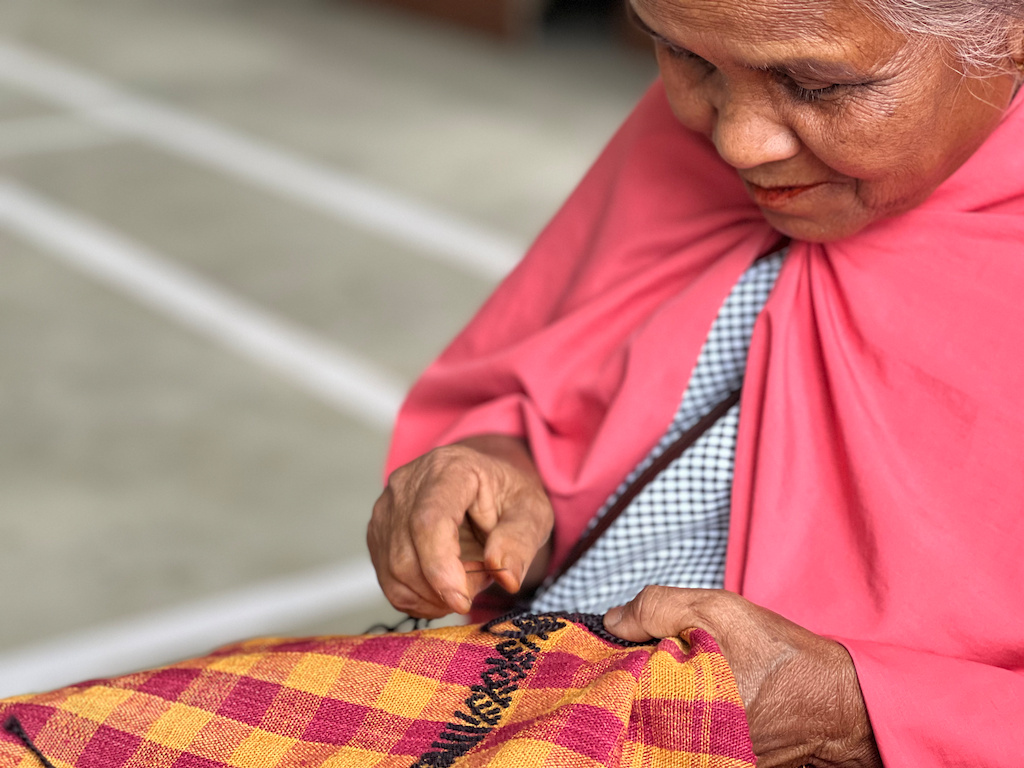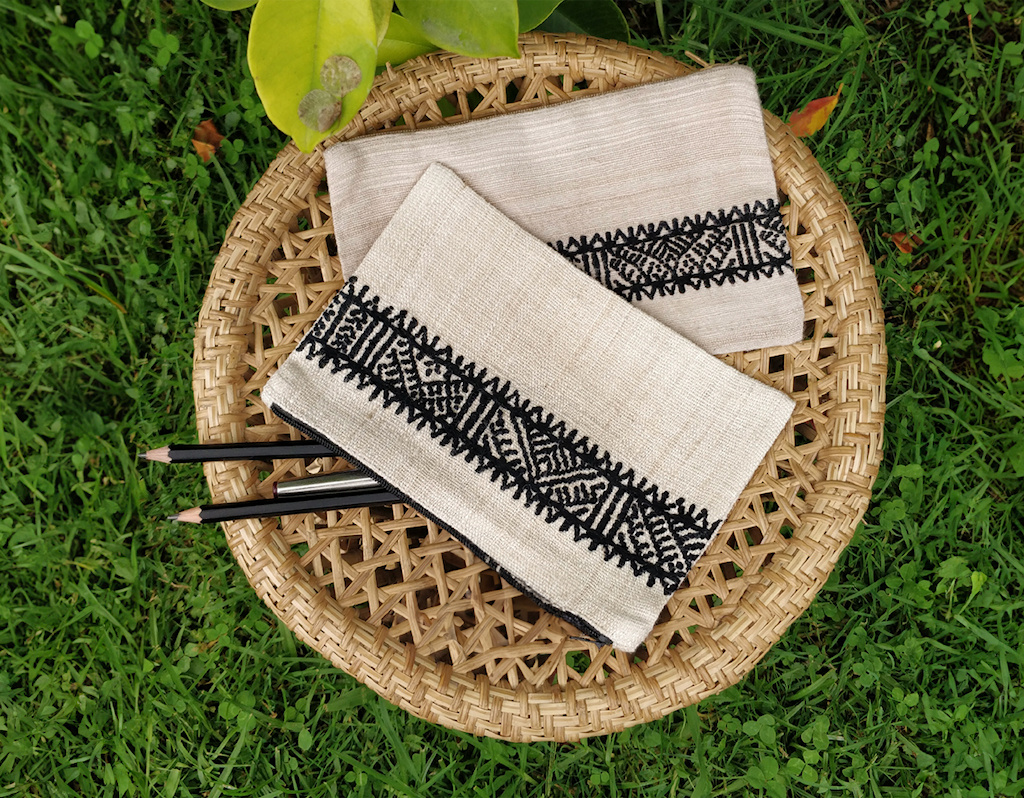Nisaphi Lyndem returns to her roots in Meghalaya to celebrate a beautiful craft tradition of the Khasi hills.
After nearly seven years, I found myself once again journeying with my students to Mustoh, a quiet village nestled in the heart of Meghalaya, India, to witness the resilience of a nearly lost tradition—Khneng embroidery. This intricate and painstaking craft, the only embroidery form practised in the Khasi hills, had once teetered on the edge of extinction. Passed down through generations, from mothers or grandmothers to daughters, it is a symbol of heritage, patience, and storytelling.

Khneng embroidery artisan using thread count technique to create the design on a traditional checkered shawl, 2025.
As a woman of Khasi roots now living in a metropolitan landscape, I often feel an irresistible pull towards my homeland—the trees, waterfalls, the living root bridges that bear the weight of time and memory. There is something profoundly human about standing before a living root bridge, its interwoven roots looking almost skin-like, and the touch, evoking a sense of homecoming. A feeling you could never experience anywhere else! For me, every visit is a necessity, a pilgrimage to reconnect with the essence of where I come from. It is in these journeys that I find solace, a reminder of the emotions and sensations that concrete jungles often erase.
During our visit, we were embraced by artisans whose hands move with the wisdom of generations who came before them. An exceptional traditional skill they shared with us was ‘Khneng embroidery’—an intricate and tedious art that has adorned Eri silk for nearly 200 years. In the olden days, this embroidery was used to adorn plaid wraparounds (Jainpein) and shawls (Jainkup) worn by the ‘War’ people of Mustoh and Shella.
The name ‘Khneng’—meaning ‘border’ in Khasi—reminds us that some traditions, though fragile, can still hold strong. Not long ago, this art nearly disappeared, its legacy entrusted to just three remaining embroiderers. But today, that number has grown through perseverance and the support of community spirit. Ten master embroiderers now carry the stitch forward, and with them, the hope of a revival.
The embroidery itself is an art of precision—meticulous thread counting, unwavering focus, and a harmony between the eyes and hands. Inspired by a local centipede-like insect or ‘Ktiar’ and the patterns of nature: the undulating Khasi hills, the rays of the sun, the delicate veins of a leaf. History tells us that Khneng embroidery may have been born from a woman’s fascination with the rhythmic sound of an insect in the woods. But in the absence of written records, the true origins still remain a mystery.
We sat with the embroiderers, listening to their stories of perseverance. Many of them work against the weight of time and financial hardship, yet they have taken it upon themselves to train 15 more women in 2025, ensuring that this tradition does not slip into the past. Their strength is fortified by those who believe in them—partners, well-wishers, and organizations that step in when support is needed.
And in this journey of revival, a beautiful transformation is taking place. No longer confined to its traditional forms, Khneng embroidery is evolving. The artisans are experimenting with new materials, cotton and tussar threads instead of only wool, shifting from shawls to handkerchiefs, neckties, cushion covers, and garments. With training from the Usha Silai program and the Meghalaya State Rural Livelihoods Society, many have begun designing and stitching their own products—reclaiming not only their craft but also their independence.
For me, returning to this land, documenting its stories, and witnessing this quiet revolution fills me with an indescribable pride.
For me, returning to this land, documenting its stories, and witnessing this quiet revolution fills me with an indescribable pride. Khneng embroidery, once on the brink of being forgotten, is finding its way back into the world—one stitch, one artisan, one story at a time.
And in this revival, there is a lesson: that heritage is not just something we inherit, but something we fight for. It is the unbreakable thread that binds us to our roots, to each other, and to timeless creation.
About Nisaphi Lyndem
 Dr. Nisaphi Lyndem is a researcher, educator, and writer with a PhD in Design, specialising in Indigenous Textiles and Anthropology. Her doctoral thesis, “Cultural Appropriation and Semiotic Study of Textiles Handwoven in Nagaland: The Angami and Sangtam Tribes,” examines the intersections of culture and meaningful representation in tribal textiles. Committed to bridging traditional cultural practices with sustainable livelihoods, Dr. Lyndem advocates for the recognition of textiles created by minority communities. She emphasises the vital role of handloom weaving in Northeast India, particularly as a means of economic empowerment for women and believes that weaving should be integrated into a holistic approach that enhances artisans’ overall well-being. Through education and advocacy, she encourages individuals and students to actively contribute to the preservation and ethical appreciation of cultural traditions. Visit culturenortheast.blogspot.com and connect at www.linkedin.com/in/dr-nisaphi-l-lyndem-819b91161
Dr. Nisaphi Lyndem is a researcher, educator, and writer with a PhD in Design, specialising in Indigenous Textiles and Anthropology. Her doctoral thesis, “Cultural Appropriation and Semiotic Study of Textiles Handwoven in Nagaland: The Angami and Sangtam Tribes,” examines the intersections of culture and meaningful representation in tribal textiles. Committed to bridging traditional cultural practices with sustainable livelihoods, Dr. Lyndem advocates for the recognition of textiles created by minority communities. She emphasises the vital role of handloom weaving in Northeast India, particularly as a means of economic empowerment for women and believes that weaving should be integrated into a holistic approach that enhances artisans’ overall well-being. Through education and advocacy, she encourages individuals and students to actively contribute to the preservation and ethical appreciation of cultural traditions. Visit culturenortheast.blogspot.com and connect at www.linkedin.com/in/dr-nisaphi-l-lyndem-819b91161






